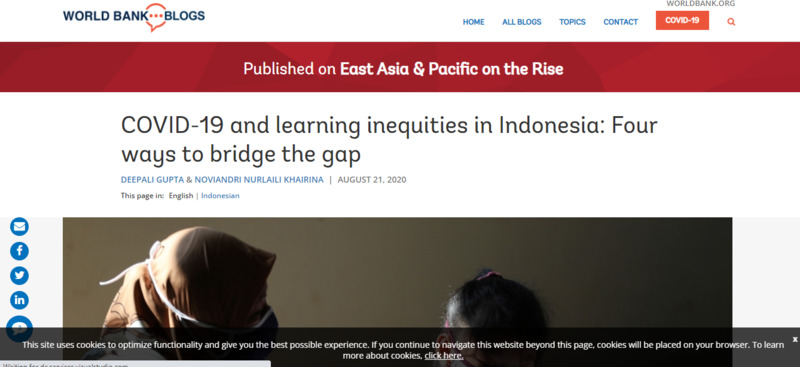Item
How Indonesia's Education System Is Faring
Title (Dublin Core)
How Indonesia's Education System Is Faring
Description (Dublin Core)
"Since March 2020, students, parents, and teachers in Indonesia have been grappling with school closures affecting 62.5 million students from pre-primary to higher education."
With such a socioeconomically diverse population, it's difficult to gauge just how accessible isolated learning would really be during the pandemic. The Ministry of Education and Culture had to move quickly to assure that there was some structure and guidelines set in place for educational institutions to follow. Unfortunately, as internet access isn't quite the common luxury many households have, the ministry sought partnership with television programming stations. This was to, at least, provide educational material to those who have access to televisions but not internet.
The article goes on to provide four ways in which they hoped would assist in the growing education deficiency. 1) Develop more solutions to reach students without internet access; 2) Increase connectivity and train teachers to deliver more effective and interactive online learning; 3) Identify and support those falling behind with differentiated instruction; 4) Support disadvantaged students to return to school.
With such a socioeconomically diverse population, it's difficult to gauge just how accessible isolated learning would really be during the pandemic. The Ministry of Education and Culture had to move quickly to assure that there was some structure and guidelines set in place for educational institutions to follow. Unfortunately, as internet access isn't quite the common luxury many households have, the ministry sought partnership with television programming stations. This was to, at least, provide educational material to those who have access to televisions but not internet.
The article goes on to provide four ways in which they hoped would assist in the growing education deficiency. 1) Develop more solutions to reach students without internet access; 2) Increase connectivity and train teachers to deliver more effective and interactive online learning; 3) Identify and support those falling behind with differentiated instruction; 4) Support disadvantaged students to return to school.
Date (Dublin Core)
Creator (Dublin Core)
Contributor (Dublin Core)
Type (Dublin Core)
Text Story
Link (Bibliographic Ontology)
https://blogs.worldbank.org/eastasiapacific/covid-19-and-learning-inequities-indonesia-four-ways-bridge-gap
Publisher (Dublin Core)
Worldbank.org
Controlled Vocabulary (Dublin Core)
English
Education--K12
English
Education--Universities
English
Economy
English
Technology
English
Social Distance
English
Social Class
English
Online Learning
English
Government Federal
English
Business & Industry
Curator's Tags (Omeka Classic)
Contributor's Tags (a true folksonomy) (Friend of a Friend)
Collection (Dublin Core)
Date Submitted (Dublin Core)
03/21/2021
Date Modified (Dublin Core)
03/21/2021
03/22/2021
11/14/2021
Date Created (Dublin Core)
08/21/2020
Item sets
This item was submitted on March 21, 2021 by Fitria Hardono using the form “Share Your Story” on the site “A Journal of the Plague Year”: http://mail.covid-19archive.org/s/archive
Click here to view the collected data.
